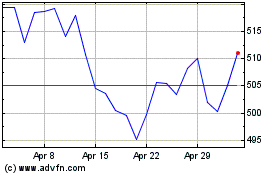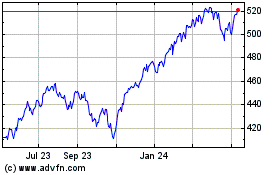Will the S&P 500 Index Move Higher This Week?
November 13 2023 - 4:54AM
Finscreener.org
The
S&P 500 index fell
close to 10% between August and October 2023 due to geopolitical
tensions, elevated inflation, and rising interest rates, resulting
in a sluggish macro economy.
However, as economic activity
remains tepid globally, experts believe it will allow countries to
rein in inflation in the next 12 months. This, combined with the
possibility of normalizing interest rates, has driven the
S&P 500 index higher by 8% this month.
Let’s see what should drive the
equity markets in the next week.
Moody’s cuts U.S. outlook to negative
MoodyU+02019s Investors Service
downgraded its outlook on the U.S. governmentU+02019s credit rating
to negative from stable on Friday, signaling escalating concerns
over the nationU+02019s fiscal strength. While maintaining the
U.S.U+02019s Aaa long-term issuer and senior unsecured ratings,
MoodyU+02019s warned that the U.S. is expected to sustain
substantial fiscal deficits without effective fiscal measures to
curb spending or enhance revenue. According to MoodyU+02019s, this
is set to markedly diminish debt affordability, especially in the
current climate of rising interest rates.
The rating agency also cited the
political leadership in Washington as a detrimental influence,
suggesting that ongoing division within Congress heightens the risk
of an inability to agree on fiscal strategies to mitigate the
downward trajectory of debt affordability.
Despite these concerns,
MoodyU+02019s affirmed the top-tier Aaa rating, anticipating the
U.S. will maintain its exceptional economic vigor and suggesting
that any further positive economic developments could decelerate
the worsening of debt affordability.
Is another government shutdown on the
cards?
Responding to MoodyU+02019s
outlook shift, Deputy Secretary of the Treasury Wally Adeyemo
expressed disagreement, emphasizing the strength of the U.S. economy and
the global trust in Treasury securities.
The downgrade in outlook
coincides with Congress facing another potential government
shutdown. Currently funded until November 17, disagreements persist
in Congress regarding a long-term funding solution.
House Speaker Mike Johnson has
announced intentions to reveal a Republican funding strategy on
Saturday, setting up a potential vote for Tuesday. However, through
December 7 for some government areas and through January 19 for
others, his approach of staggered funding has been deemed nonviable
by the White House and the Democrat-majority Senate.
The White House has attributed
MoodyU+02019s decision to alter the U.S. outlook to the extreme and
dysfunctional behaviors of Congressional Republicans.
This change by MoodyU+02019s
follows a similar move by Fitch in August, which lowered the
U.S.U+02019s long-term foreign currency issuer default rating,
citing projected fiscal decline over the next few years, weakening
governance, and an increasing debt burden. Fitch also noted that
the recurrent confrontations and last-minute resolutions regarding
the debt ceiling have undermined confidence in the U.S.U+02019s
fiscal stewardship.
Analysts expect the S&P 500 earnings to surge 11%
in 2024
According to Nicholas Colas from
DataTrek Research, while there is a chance for the U.S. economy to
enter a recession in 2024, these concerns are not reflected in
consensus estimates. According to average analyst estimates, the
S&P 500 is forecast to increase adjusted earnings by 11%
year over year to $246 per share in 2024, up from $221 per share in
2023.
Colas explains, “The S&P
trades for 18x analysts’ 2024 estimates, but 28x a 30 percent
decline from this year’s earnings. The latter number seems
unrealistically high if the US really is heading into a recession
next year.”
SPDR S&P 500 (AMEX:SPY)
Historical Stock Chart
From Mar 2024 to Apr 2024

SPDR S&P 500 (AMEX:SPY)
Historical Stock Chart
From Apr 2023 to Apr 2024
